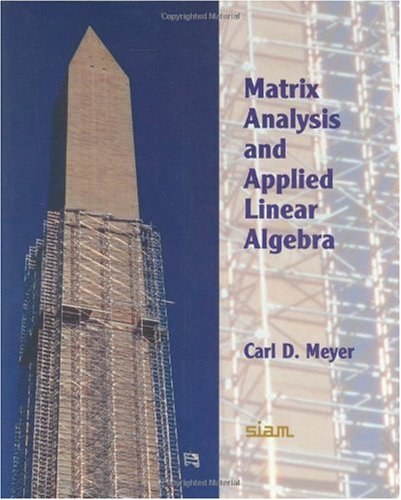Matrix Analysis and Applied Linear Algebra
豆瓣
Carl D. Meyer
简介
Matrix Analysis and Applied Linear Algebra is an honest math text that circumvents the traditional definition-theorem-proof format that has bored students in the past. Meyer uses a fresh approach to introduce a variety of problems and examples ranging from the elementary to the challenging and from simple applications to discovery problems. The focus on applications is a big difference between this book and others. Meyer's book is more rigorous and goes into more depth than some. He includes some of the more contemporary topics of applied linear algebra which are not normally found in undergraduate textbooks. Modern concepts and notation are used to introduce the various aspects of linear equations, leading readers easily to numerical computations and applications. The theoretical developments are always accompanied with examples, which are worked out in detail. Each section ends with a large number of carefully chosen exercises from which the students can gain further insight.
The textbook contains more than 240 examples, 650 exercises, historical notes, and comments on numerical performance and some of the possible pitfalls of algorithms. It comes with a solutions manual that includes complete solutions to all of the exercises. As an added bonus, a CD-ROM is included that contains a searchable copy of the entire textbook and all solutions. Detailed information on topics mentioned in examples, references for additional study, thumbnail sketches and photographs of mathematicians, and a history of linear algebra and computing are also on the CD-ROM, which can be used on all platforms.
Students will love the book's clear presentation and informal writing style. The detailed applications are valuable to them in seeing how linear algebra is applied to real-life situations. One of the most interesting aspects of this book, however, is the inclusion of historical information. These personal insights into some of the greatest mathematicians who developed this subject provide a spark for students and make the teaching of this topic more fun.
contents
Chapter 1: Linear Equations.
Introduction; Gaussian Elimination and Matrices; Gauss-Jordan Method; Two-Point Boundary-Value Problems; Making Gaussian Elimination Work; Ill-Conditioned Systems
Chapter 2: Rectangular Systems and Echelon Forms.
Row Echelon Form and Rank; The Reduced Row Echelon Form; Consistency of Linear Systems; Homogeneous Systems; Nonhomogeneous Systems; Electrical Circuits
Chapter 3: Matrix Algebra.
From Ancient China to Arthur Cayley; Addition, Scalar Multiplication, and Transposition; Linearity; Why Do It This Way?; Matrix Multiplication; Properties of Matrix Multiplication; Matrix Inversion; Inverses of Sums and Sensitivity; Elementary Matrices and Equivalence; The LU Factorization
Chapter 4: Vector Spaces.
Spaces and Subspaces; Four Fundamental Subspaces; Linear Independence; Basis and Dimension; More About Rank; Classical Least Squares; Linear Transformations; Change of Basis and Similarity; Invariant Subspaces
Chapter 5: Norms, Inner Products, and Orthogonality.
Vector Norms; Matrix Norms; Inner Product Spaces; Orthogonal Vectors; Gram-Schmidt Procedure; Unitary and Orthogonal Matrices; Orthogonal Reduction; The Discrete Fourier Transform; Complementary Subspaces; Range-Nullspace Decomposition; Orthogonal Decomposition; Singular Value Decomposition; Orthogonal Projection; Why Least Squares?; Angles Between Subspaces
Chapter 6: Determinants.
Determinants; Additional Properties of Determinants
Chapter 7: Eigenvalues and Eigenvectors.
Elementary Properties of Eigensystems; Diagonalization by Similarity Transformations; Functions of Diagonalizable Matrices; Systems of Differential Equations; Normal Matrices; Positive Definite Matrices; Nilpotent Matrices and Jordan Structure; The Jordan Form; Functions of Non-diagonalizable Matrices; Difference Equations, Limits, and Summability; Minimum Polynomials and Krylov Methods
Chapter 8: Perron-Frobenius Theory of Nonnegative Matrices.
Introduction; Positive Matrices; Nonnegative Matrices; Stochastic Matrices and Markov Chains.